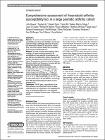| dc.contributor.author | Mc Manus, Ross | en |
| dc.contributor.author | Kane, David | en |
| dc.date.accessioned | 2020-03-03T15:54:43Z | |
| dc.date.available | 2020-03-03T15:54:43Z | |
| dc.date.issued | 2012 | en |
| dc.date.submitted | 2012 | en |
| dc.identifier.citation | Bowes J, Ho P, Flynn E, Marzo-Ortega H, UKRAG Consortium, Coates L, McManus R, Ryan A, Kane D, Korendowych E, McHugh N, FitzGerald O, Packham J, Morgan AW, Bruce IN, Barton A, Comprehensive assessment of rheumatoid arthritis susceptibility loci in a large psoriatic arthritis cohort, Annals of Rheumatic Diseases, 71, 8, 2012, 1350-1354 | en |
| dc.identifier.other | Y | en |
| dc.identifier.uri | https://ard.bmj.com/content/71/8/1350 | |
| dc.identifier.uri | http://hdl.handle.net/2262/91681 | |
| dc.description | ACCEPTED | en |
| dc.description.abstract | Objective:
A number of rheumatoid arthritis (RA)
susceptibility genes have been identified in recent years.
Given the overlap in phenotypic expression of synovial
joint inflammation between RA and psoriatic arthritis
(PsA), the authors explored whether RA susceptibility
genes are also associated with PsA.
Methods:
56 single nucleotide polymorphisms (SNPs)
mapping to 41 genes previously reported as RA
susceptibility loci were selected for investigation. PsA
was defined as an inflammatory arthritis associated with
psoriasis and subjects were recruited from the UK and
Ireland. Genotyping was performed using the Sequenom
MassArray platform and frequencies compared with data
derived from large UK control collections.
Results:
Significant evidence for association with
susceptibility to PsA was found to a SNP mapping to
the
REL
(rs13017599, p
trend
=5.2?10
4
) gene, while
nominal evidence for association (p
trend
<0.05) was
found to seven other loci including
PLCL2
(rs4535211,
p=1.7?10
?3
);
STAT4
(rs10181656, p=3.0?10
?3
) and
the
AFF3
,
CD28
,
CCL21
,
IL2
and
KIF5A
loci. Interestingly,
three SNPs demonstrated opposite effects to those
reported for RA.
Conclusions:
The
REL
gene, a key modulator of the
NF
?
B pathway, is associated with PsA but the allele
conferring risk to RA is protective in PsA suggesting that
there are fundamental differences in the aetiological
mechanisms underlying these two types of inflammatory
arthritis | en |
| dc.description.sponsorship | The authors acknowledge the support of the NIHR
Manchester Biomedical Research Centre and NIHR Leeds Musculoskeletal Biomedical
Research Unit. John Bowes, Ian Bruce and Anne Barton are funded by Arthritis
Research UK (arc grant; 17552). Edward Flynn is supported by the European
Community?s Sixth Framework Programme AutoCure funding. This study makes use
of data generated by the Wellcome Trust Case-Control Consortium. A full list of the
investigators who contributed to the generation of the data is available from
www.
wtccc.org.uk.
Funding for the project was provided by the Wellcome Trust under
award 076113 and 085475. | en |
| dc.format.extent | 1350-1354 | en |
| dc.language.iso | en | en |
| dc.relation.ispartofseries | Annals of Rheumatic Diseases | en |
| dc.relation.ispartofseries | 71 | en |
| dc.relation.ispartofseries | 8 | en |
| dc.rights | Y | en |
| dc.subject | Rheumatoid arthritis (RA) | en |
| dc.subject | Single nucleotide polymorphisms | en |
| dc.subject | Psoriatic arthritis | en |
| dc.subject.lcsh | rheumatoid arthritis (RA) | en |
| dc.title | Comprehensive assessment of rheumatoid arthritis susceptibility loci in a large psoriatic arthritis cohort | en |
| dc.type | Journal Article | en |
| dc.type.supercollection | scholarly_publications | en |
| dc.type.supercollection | refereed_publications | en |
| dc.identifier.peoplefinderurl | http://people.tcd.ie/rmcmanus | en |
| dc.identifier.peoplefinderurl | http://people.tcd.ie/kanedj | en |
| dc.identifier.rssinternalid | 77042 | en |
| dc.identifier.doi | http://dx.doi.org/10.1136/annrheumdis-2011-20080 | en |
| dc.subject.TCDTheme | Genes & Society | en |
| dc.subject.TCDTheme | Immunology, Inflammation & Infection | en |




